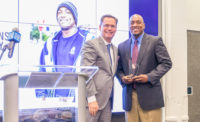It’s no secret that today’s construction equipment manager faces a wide range of challenges in effectively managing a fleet, and the rapid evolution of technology, the impact of safety and effectively building a team of fleet professionals are clearly influencing a fleet professional’s success.
It’s why equipment managers in C-level suites place a premium on understanding, exploring and deploying all the methodologies they can for these three key factors in their daily efforts. It is why, when surveyed, they have identified safety, telematics and workforce development as the three most critical issues they face day in, day out.
All three of these issues are tightly interrelated, each are dependent for measuring success, and the equipment manager who recognizes their potential is the equipment manager who sits at the board table of the successful fleet intensive company, because when addressed in tandem these issues present opportunity for broader successes.
Big Data’s Big Impact
Technology is already proving its worth in effectively managed fleets. Telematics has evolved from tracking simply hours and location to a multipurpose tool providing key maintenance and management metrics for individual pieces of equipment and the fleet. Utilized effectively, it even enables technicians and operators to ascend into key management roles within fleet operations.
A technician with access to telematics data is a powerful and effective member of a fleet team. Technicians can effectively diagnose equipment predictively instead of reactively, resulting in more uptime—more efficiencies. And a technician empowered to make the decision on when repairs and maintenance are needed, who has the trust of upper management in fleet services and a strong working relationship with the dealer or OEM, can further deliver valuable uptime and greater profits.
Operators, when properly trained, can add to those efficiencies because the data you have available through telematics empowers you and your operators to better understand the impact they have on equipment—again, more uptime and higher profits.
The skill sets needed are rich and fulfilling, and based on the needs of the future. Except the future is now.
Safety Changes Perceptions
Technology has played a big role in creating a safer workplace in fleet-intensive companies. Original equipment manufacturers, or OEMs, use telematics data to create safer machines. Technology-enabled equipment—safety vests, hardhats, autonomous equipment and even tech-enabled tools such as lights and more—are creating a working environment where everything is connected. Because of this, there is a much higher situational awareness on the job site. It’s becoming safer.
A safer job site can provide the industry with the perception that working around heavy equipment is a great place for a career. In the not so distant future, the fleet intensive worksite will no longer be viewed as dangerous, dirty and undesirable to kids and their parents if the industry can deliver on an industry brand and perception that is rooted in technology and safety.
The mission statement for such a brand could easily come straight out of the book and movie “The Martian.” The hero and his team were there to explore, but a key part of the job was digging stuff up. Sure, it is pretty risky to go to Mars, but the book demonstrates the use of technology, safety, good old problem solving and elbow grease in making a job on Mars not only exciting but also cool.
These same ideas could easily describe the work of those engaged in heavy equipment maintenance and management.
So, why not brand this profession as being vital to the future, with four equal parts of technical know-how, safety, problem solving and rewarding hard work?
An entire generation of Martians is about to enter the workforce.
The GenTech Workforce
As approximately 10,000 Boomers retire every day, and just as the skills and knowledge gaps have the potential to widen, along comes Generation Z (late '90s forward). I prefer to call them Generation Tech, and they can save this industry’s bacon. They understand technologies. They are the first generation to be born with a smart device in their hands. They are the first truly connected generation.
This is both our challenge and opportunity. By branding the industry as futuristic, technology based and safe, where individuals are empowered to use their problem-solving skills, we can successfully attract the GenTechs to this industry.
We must build an industry brand that is as high-tech as NASA. An industry that is safer, cleaner, technology-based and truly impacting society and the planet is key to this generation. We can build this future with a new generation of workers accepting of technology and new ideas, and who seek fulfillment and excitement in a job that helps move the world forward.
Let’s go find some Martians.
Stan Orr, FASAE, CAE, is the President and Chief Strategy Officer of the Association of Equipment Management Professionals (AEMP), having served in that capacity since 1999. AEMP is dedicated to the art and science of heavy equipment management. For more information, visit www.aemp.org.



Post a comment to this article
Report Abusive Comment